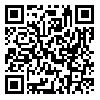Volume 12, Issue 2 (6-2022)
J Health Saf Work 2022, 12(2): 384-402 |
Back to browse issues page
Download citation:
BibTeX | RIS | EndNote | Medlars | ProCite | Reference Manager | RefWorks
Send citation to:



BibTeX | RIS | EndNote | Medlars | ProCite | Reference Manager | RefWorks
Send citation to:
Alizadeh Z, Pouyakian M, Etemad K. The role of individual and psychological differences in the occurrence of unsafe behaviors: a cross-sectional study between the employees of a turbine manufacturing company. J Health Saf Work 2022; 12 (2) :384-402
URL: http://jhsw.tums.ac.ir/article-1-6690-en.html
URL: http://jhsw.tums.ac.ir/article-1-6690-en.html
1- Department of Occupational Health and Safety Engineering, School of Public Health and Safety, Shahid Beheshti University of Medical Sciences, Tehran, Iran
2- Department of Occupational Health and Safety Engineering, School of Public Health and Safety, Shahid Beheshti University of Medical Sciences, Tehran, Iran ,pouyakian@sbmu.ac.ir
3- Department of Epidemiology, School of Public Health and Safety, Shahid Beheshti University of Medical Sciences, Tehran, Iran
2- Department of Occupational Health and Safety Engineering, School of Public Health and Safety, Shahid Beheshti University of Medical Sciences, Tehran, Iran ,
3- Department of Epidemiology, School of Public Health and Safety, Shahid Beheshti University of Medical Sciences, Tehran, Iran
Abstract: (1186 Views)
Introduction: Human beings are inherently different and this fact can affect his/her behavior in work environments. The aim of this study was to examine the individual differences of employees (personality traits, biological and demographic factors) as a predictor of unsafe behaviors in a turbine manufacturing company.
Material and Methods: In this cross-sectional study, safety behavior sampling technique, NEO-FFI questionnaire, demographic information questionnaire, BMI and cell type method were used to determine unsafe behaviors, personality traits, demographic variables, body mass index and blood group system, respectively. The statistical sample of the study was 260 employees of a turbine manufacturing industry. The SPSS software version 20 was used to analyze the data.
Results: The results showed that 44.5% of employees’ behaviors were unsafe. There was a significant relationship between the occurrence of unsafe behaviors with smoking, BMI, blood type and neuroticism and agreeableness dimensions measured by NEO-FFI (p < 0.05). BMI was the most important predictorof unsafe behaviors in the present study.
Conclusion: Due to the role of individual differences in people’s tendency to unsafe behaviors, the results of this study can be considered in job design, screening of personnel according to their individual differences, and perform better interventions to prevent accidents at work.
Material and Methods: In this cross-sectional study, safety behavior sampling technique, NEO-FFI questionnaire, demographic information questionnaire, BMI and cell type method were used to determine unsafe behaviors, personality traits, demographic variables, body mass index and blood group system, respectively. The statistical sample of the study was 260 employees of a turbine manufacturing industry. The SPSS software version 20 was used to analyze the data.
Results: The results showed that 44.5% of employees’ behaviors were unsafe. There was a significant relationship between the occurrence of unsafe behaviors with smoking, BMI, blood type and neuroticism and agreeableness dimensions measured by NEO-FFI (p < 0.05). BMI was the most important predictorof unsafe behaviors in the present study.
Conclusion: Due to the role of individual differences in people’s tendency to unsafe behaviors, the results of this study can be considered in job design, screening of personnel according to their individual differences, and perform better interventions to prevent accidents at work.
Keywords: Unsafe behavior sampling, Personality traits, Demographic variables, BMI, ABO blood group system
Type of Study: Research |
Received: 2022/06/26 | Accepted: 2022/06/22 | Published: 2022/06/22
Received: 2022/06/26 | Accepted: 2022/06/22 | Published: 2022/06/22
Send email to the article author
| Rights and permissions | |
 |
This work is licensed under a Creative Commons Attribution-NonCommercial 4.0 International License. |






